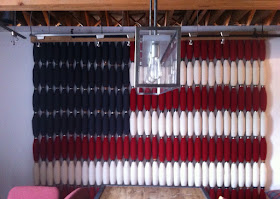Minnesota. Land of 1,000 Lakes. Up north. Boundary waters.
Will repeat one of my earliest (2009) 10E
I fully support one of the planks of the recent "buy American" movement; that is to buy goods from their original manufacturers. Boots and blankets should come from Minnesota, camping gear from Oregon (or California) and moccasins from Maine. Plus, coats come from Dakota and pencils come from Pennsylvania... Right?!After hitting MN State Fair last week, we had a chance to visit the Faribault Mill (of US Army foot locker blanket fame) - about 30 minutes south of Minneapolis off 35. Tours are on Thursdays - and you MUST call ahead - 2 weeks ahead even better. To reserve a spot email info@faribaultmill.com or call 507-412-5534 - link.
"Founded in 1865, the year Lincoln died and the Civil War ended, Faribault woolens are renowned for their comfort and quality. From providing woolen blankets for pioneers heading west to comforting our troops through two world wars, our woolens are woven into American history."The mill sits on the Cannon River and was water powered until the 1930s I believe. It is possibly the last completely vertically integrated US mill still in operation - that is starting with raw wool and ending with a finished product for retail.
You may have seen factory video filmed by RED cams and a slick dolly but you only get the noise and the smell (lanolin folks) and the asides by going in person. From raw wool to dying to carding to spinning, weaving and finishing.
These machines are WWII era. 1 guy in town services them. He makes custom parts in his shop when needed... This is after carding (getting all fibers going in same direction) and starts to twist them for strength. If the wool breaks the machine stops - a tech - lady below on our day - whips a pipe cleaner out of her hair and twists the strands back together to reconnect and off they go...
Change is everything of course... so the wool from bobbins above have to be restrung onto the larger ones below as the old bobbins don't fit the newer looms.
Here is our guide Lynn Kiefer giving a snapshot description of the creation of Faribault's Recycled Throw. I love the look of these - remind me of the lining on my old denims. And easy decision at $65.
The woven goods are then preshrunk or treated with moth-proofing (soldiers' blankets) retardants or other washes for industrial use or napped again for softness - before inspected.
Longish article here that details the resurrection of the mill from factory to brand - the mill had been shuttered a few years ago before Paul Motty and his cousin and others stepped in;
"...once employing as many as 200. But five years ago it was dead.
Owned from its founding in 1865 to the 1990s by the Klemer and Johnson families, it had long been a business known for blankets, which constituted up to 90 percent of its output. It produced durable wool items for the U.S. military, and decades-old pieces still warm beds all over North America. But as manufacturing moved offshore, driving down prices, and the high-tech synthetics (see fleece) boom took over the market, Faribault declined.
...By the time of its closure in ’09, only 35 people worked inside the mill...
In early 2011, current co-owner and CFO Paul Mooty, who was managing family business interests and “hunting for life’s next great adventure,” received a call from a college buddy seeking advice—his father had a letter of intent to buy the mill’s assets. Mooty brought his cousin, current Jostens CEO and Minnesota management legend Chuck Mooty, to kick the tires. A Pakistani group had bid on the mill’s equipment, so time was of the essence if the mill was to be preserved.
By summer the Mootys had bought the facility and applied to have it placed on the National Register of Historic Places, which gave them access to tax credits that were key to its resurrection.
...Paul Mooty recalls. “At some point there was a movement on faith, but it’s rare to find a 145-year-old business [with] functioning equipment intact, a resonant brand, etc. Also, we liked the opportunity to get involved in doing something good.”"If you are in the Twin Cities also be sure to stop in at Wilson & Willy's - that shop owner John Mooty (son of new mill owners) had been working on designs for Fairbault too, for example the Shadow Plaid with All Plaidout and other collaborations.
"First introduced in 1949, the Pak-A-Robe is a plaid stadium throw (also known as a “robe”) paired with a matching carrying case, which doubles as a seat cushion. For our reissue we partnered with Duluth Pack to construct a case from stout canvas with a bridle leather handle and zipper pull." Love these - ed.
Faribault Mill HQ.









